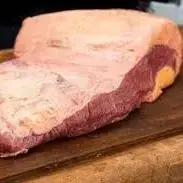




Beef Brisket
Product Description
Beef brisket is a cut of meat taken from the breast or lower chest of the cow, just below the shoulder. It's known for its rich flavor and marbling, which makes it ideal for slow-cooking methods that tenderize the meat over time. Order at Meat station Characteristics: Texture and Flavor: Brisket is a tough cut due to the connective tissue and muscle fibers, but it becomes tender and flavorful when cooked low and slow. The fat cap on brisket also renders down during cooking, adding moisture and richness. Size and Shape: A full brisket can be quite large, typically weighing between 10-20 pounds. It's often divided into two parts: the flat (leaner) and the point (fattier). Cooking Tips: Slow Cooking: Brisket is best cooked slowly over low heat, whether through braising, smoking, or slow roasting. This allows the collagen in the meat to break down, resulting in a tender, juicy dish. Smoking: Brisket is a popular choice for smoking, especially in barbecue. It’s cooked for many hours at a low temperature, often with a dry rub or marinade. Braising: In traditional recipes like Jewish pot roast or corned beef, brisket is often braised with vegetables and liquid until it becomes tender. Popular Dishes: Texas-style Smoked Brisket: A signature dish in Texas barbecue, this involves a long smoking process over wood, usually seasoned simply with salt and pepper. Corned Beef: Brisket cured in brine and spices, then typically boiled or braised, often associated with St. Patrick’s Day. Pot Roast: A braised dish where brisket is cooked slowly with vegetables and broth. -Brisket Tacos: Shredded or chopped brisket used as a filling for tacos, often with barbecue or spicy flavors. Nutritional Information: Brisket is a relatively high-calorie cut due to its fat content, but it’s also a good source of protein, iron, and other nutrients. The calorie content can vary depending on whether you’re eating the leaner flat or the fattier point. Tips for Slicing: After cooking, brisket should be sliced against the grain to ensure tenderness. Slicing with the grain can result in tough, chewy pieces. ...Read More

